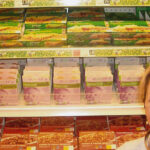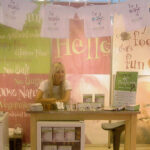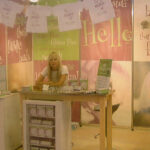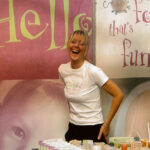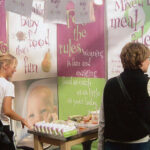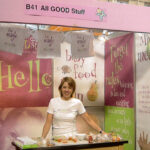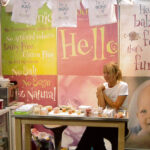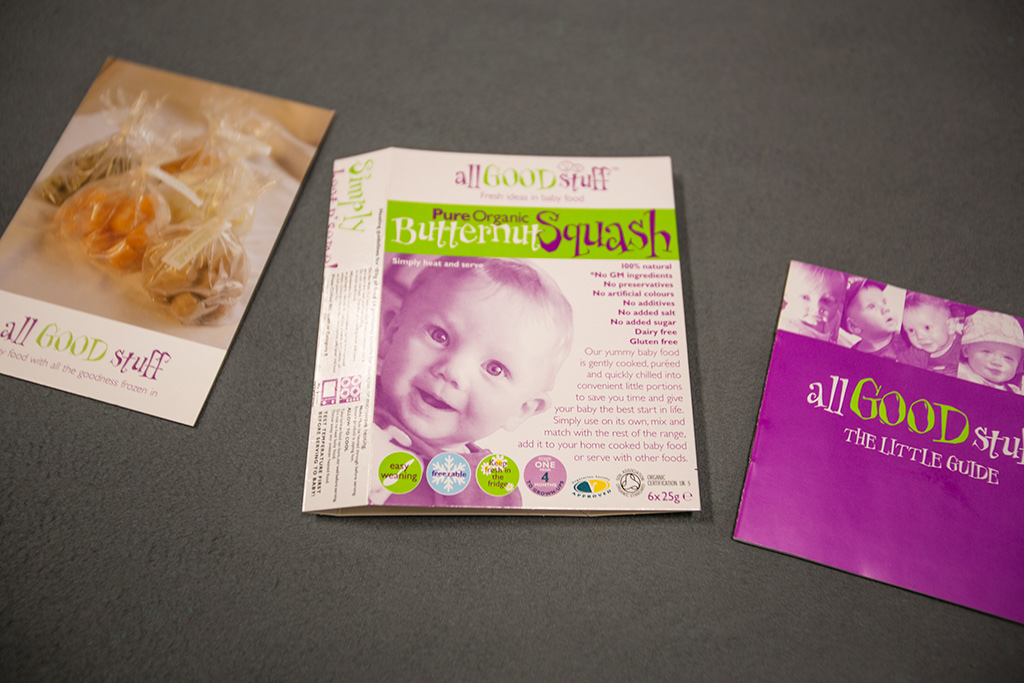
When we say we understand freedom and free from brands from the experience we’ve gained ourselves, well we really do mean it, we have literally walked in your shoes.
During 2001 to 2004 we launched All GOOD Stuff. A range of gluten and dairy free infant food, it was snap frozen so therefore had not been subject to pasteurized processes either (another growing trend and category today!).
All GOOD stuff a free from brand and product range created in our own kitchen made its way on to supermarket shelves because we got the marketing right, and we knew our audience and marketplace too.
Back then there were no Dragons on the television to pitch to to get the funding and expertise we so desperately needed to make it all happen.
People often ask me “Why don’t you do it again now?”.
Surely with the rise of free from (and that fact that the category is still not saturated with competitors) it would make sense to do just that.
But for lots of reasons we have chosen not to do it again, and instead work with other free from brands by adding value and channeling all our experience into their journey, using all the valuable experience and insight I gained on mine.
Here’s our free-from brand story…
It was 2001, I was new mum of Harry, my first baby. My job was an Account Director in an advertising agency, and my husband was Creative Director.
After just 6 months on maternity leave I was soon back at work with a baby to wean and feed, and precious little time on my hands.
As a working mum I was shocked to discover no healthy, fresh convenient food for my baby on supermarket shelves, only processed jars of brown gunk!
Not only did Harry dislike the taste of the jarred food, it apparently made him ill. On weaning him he started to have all kinds of problems with his skin, baby eczema appeared all over his body and he generally was upset when I fed him.
So I did what most good mums do, I bought Annabel Karmel’s baby food book and began making my own baby food, freezing it in ice cube trays. To try to work out what was upsetting Harry I also made single ingredient pureed food free from additives, preservatives and meat and dairy.
Harry’s upset tummy and baby eczema cleared up, as if by magic. The purity of home cooked, single ingredient food, free from everything that was over processed appeared to do the trick.
Feeding Harry became a joy, it was convenient and ready to heat and serve, as he opened his mouth wide for the next spoonful my mother said to him “Come on! This is full of All GOOD Stuff!”.
That was the lightbulb moment, in that split second I realized that not only was there an unmet need (surely I was not the only mum who needed food like this for their child at their convenience) but potentially I had a brand; and All GOOD Stuff, baby food with all the goodness frozen in was born.
Our years of industry expertise working in marketing, branding, packaging and advertising, together with the knowledge that we had a great PR story meant that within months All GOOD Stuff was on sale in local delis and independent shops in Cheshire as word spread, and I found myself featured in local and regional news titles, as well as on the front of Allergy Matters Magazine!
My dreams of being a cover girl also met! (albeit I am featured next to a bed bug!).
It was a long, hard road. Making small batches as a cottage industry in our own domestic kitchen was very challenging with a small baby, and distributing a frozen product equally so.
But that did not stop us sending our story and samples of our products to the category buyers of the big supermarkets.
Surely we could scale this up. That would be easy, right?
Wrong, it was hard, but we did it.
2 years later All GOOD Stuff was on the shelves of Sainsburys, ASDA, Ocado and two major distributors to local stores throughout the UK and Ireland. We even had enquires to export.
So, what happened? Why is All GOOD Stuff not on every child’s lips today?
Well the answer is complex but simple. The journey was littered with barriers, and by 2004 we had run out of money to be able to continue. We were also mentally and physically exhausted.
What we had done was achieved great success and great failure all at the same time. And it was a rollercoaster ride that sometimes I wanted to get off but couldn’t.
- INVESTMENT:
We successfully secured funding. But with the wrong investors, they did not understand FMCG or multiple retail distribution, let alone food manufacturing. - LISTINGS:
We successfully secured listings. But we were on sale in the wrong place in the store, so no one could find us. - PRODUCT RANGE & MANUFACTURING:
We successfully created 7 different products in the range and had ideas for NPD. But couldn’t find the right co-packer in time, therefore a decision was made to invest in manufacturing it ourselves, this limited our ability and increased our overheads. Even though we had indepth discussions with Annabel Karmel and Audrey Baxter, as well as the owners of Aunt Bessy. - MARKETING:
We successfully developed a compelling marketing strategy, and we had a great story, not only was it one of the first kitchen to supermarket successes, we were on a quest to ‘educate their taste buds’, We talked about child obesity which is very relevant today as obesity levels are at an all time high putting pressure on the NHS, but no one was listening because we didn’t have the funding to roll out the message properly because the factory costs sucked in all our money. - MARKET GAP:
We successfully launched new products in organics and free from categories and had a convenient solution for busy mums looking for healthier products for their babies. But the market was too premature to appreciate any of the benefits.
They say you need to fail to succeed. We successfully did that.
Our story and journey has provided us with enormous insight. We know what it takes to launch a product into multiple retail distribution, and we understand the many challenges faced back then that are still prevalent today.
Getting it right takes the right product, the right funding, the right place in the store, the right scalable production, the right marketing story and activity, the right reasons to believe, the right audience and market needs, the right timings, and a lot of guts.




